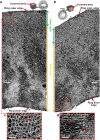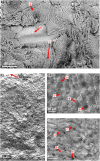Microstructure and mechanical properties of hard Acrocomia mexicana fruit shell
- PMID: 29941916
- PMCID: PMC6018112
- DOI: 10.1038/s41598-018-27282-8
Microstructure and mechanical properties of hard Acrocomia mexicana fruit shell
Abstract
Fruit and nut shells can exhibit high hardness and toughness. In the peninsula of Yucatan, Mexico, the fruit of the Cocoyol palm tree (Acrocomia mexicana) is well known to be very difficult to break. Its hardness has been documented since the 1500 s, and is even mentioned in the popular Maya legend The Dwarf of Uxmal. However, until now, no scientific studies quantifying the mechanical performance of the Cocoyol endocarp has been found in the literature to prove or disprove that this fruit shell is indeed "very hard". Here we report the mechanical properties, microstructure and hardness of this material. The mechanical measurements showed compressive strength values of up to ~150 and ~250 MPa under quasi-static and high strain rate loading conditions, respectively, and microhardness of up to ~0.36 GPa. Our findings reveal a complex hierarchical structure showing that the Cocoyol shell is a functionally graded material with distinctive layers along the radial directions. These findings demonstrate that structure-property relationships make this material hard and tough. The mechanical results and the microstructure presented herein encourage designing new types of bioinspired superior synthetic materials.
Conflict of interest statement
The authors declare no competing interests.
Figures







References
-
- Stanzl-Tschegg SE. Wood as a bioinspiring material. Mater. Sci. Eng., C. 2011;31:1174–1183. doi: 10.1016/j.msec.2010.12.001. - DOI
-
- Espinosa HD, Rim JE, Barthelat F, Buehler MJ. Merger of structure and material in nacre and bone – Perspectives on de novo biomimetic materials. Prog. Mater. Sci. 2009;54:1059–1100. doi: 10.1016/j.pmatsci.2009.05.001. - DOI
Publication types
MeSH terms
LinkOut - more resources
Full Text Sources
Other Literature Sources

